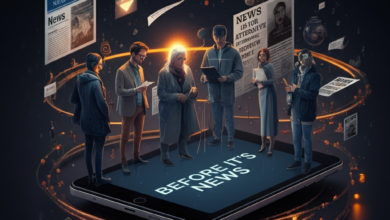Exploring Before It’s News: The Rise of Citizen Journalism in the Digital Age

With the click of a button, anyone can now share their perspective on global events. Before It’s News stands as a platform uniquely built on this premise, enabling ordinary citizens to publish news, opinions, and reports directly. But how reliable is this source? And what role does it play in shaping modern news consumption? This blog will explore the background of citizen journalism, analyze the content found on Before It’s News, and assess its reliability and impact on its audience.
The Birth of Before It’s News
Before It’s News was launched with a mission to empower everyday individuals to share what they see, hear, and think. It bypasses the traditional gatekeeping exercised by mainstream media, giving a voice to anyone who wants to report or analyze the news. From breaking news to deep-dives into societal patterns, the platform embodies the essence of free speech in journalism.
This website caters to tech-savvy readers, news junkies, and informed citizens who yearn to access unfiltered narratives. It has become a hub for citizen-driven reporting, covering a broad spectrum of topics while encouraging open dialogue between contributors and readers.
But how did citizen journalism get here? To understand Before It’s News, we must first consider the roots of this movement.
A Brief History of Citizen Journalism
Citizen journalism emerged as a response to the limitations of mainstream media. By the early 2000s, blogging platforms and social media allowed individuals outside of formal newsrooms to provide reportage. It gained further momentum with significant events like the 2004 Indian Ocean tsunami and the 2011 Arab Spring, where eyewitness accounts often reached the public before traditional outlets.
Platforms like YouTube, Twitter, and now Substack expanded the movement, enabling audio, video, and written reports on an unprecedented scale. Before It’s News capitalized on this demand for alternative and diverse perspectives, fully committing to user-generated content.
The result? A digital landscape where previously unheard voices could contribute to the global conversation. However, the rise of independence in reportage also raised questions about the accuracy, credibility, and intentions behind the information shared.
Content on Before It’s News: A Unique Angle
One reason Before It’s News has grown in popularity is its wide-ranging topics and unique approach. Unlike traditional outlets, which often focus on verified, mainstream events, this platform dives into both fact-based reporting and unconventional or niche subjects that may be overlooked elsewhere.
Topics Covered
Before It’s News provides an expansive canvas. Readers can find stories on:
- Breaking news: Urgent updates on ongoing events, often with an alternative perspective.
- Politics: Opinions and analysis across the ideological spectrum, ranging from left to right.
- Health Trends: Coverage on wellness, alternative medicine, and unorthodox health practices.
- Science and Tech: Explorations of futuristic ideas, niche technological advancements, and speculative science.
- Conspiracy Theories: Critical takes on mainstream narratives that some feel suppress uncomfortable truths.
A Platform with Personality
One of its key attractions is that contributors write in a personal, unfiltered tone. This conversational style creates a sense of authenticity and relatability for the audience. However, this same lack of formality makes it difficult to discern editorial standards or fact-checking practices, leading to concerns about content reliability.
Fact-Checking and Reliability: Can You Trust Before It’s News?
One of the primary criticisms directed toward citizen journalism platforms like Before It’s News is the lack of strict editorial oversight. Unlike legacy media organizations, which often employ reporters, editors, and fact-checkers, anyone on this platform can publish an article with relative ease.
Monitoring Credibility
- Fact-Checking: Articles on Before It’s News often lack sufficient evidence to back up claims. Some are based on speculative information or incomplete data.
- Sources: There’s a wide spectrum of credibility among contributors. Verified and well-researched pieces sit alongside dubious claims or wildly opinionated content.
- Potential Bias: Without editorial policies, contributors may bring personal agendas or unchecked biases into their work. Readers are encouraged to approach the site with a critical mindset.
While its open-door approach promotes free speech, it also creates challenges regarding misinformation. Readers must invest time in evaluating the credibility of authors and their content.
The Impact of Before It’s News on Modern News Consumption
Despite concerns over reliability, Before It’s News has undeniably influenced the broader landscape of news consumption and civic engagement.
Empowering Citizen Voices
Before It’s News democratizes journalism by providing a platform for everyone, regardless of professional credentials. This can amplify underrepresented voices or highlight events overlooked by mainstream outlets. For instance, grassroots movements and initiatives sometimes gain traction on platforms like Before It’s News before being picked up by larger media organizations.
Shaping Audience Behavior
It also reflects a shift in how audiences engage with news. Rather than passively consuming information, users of platforms like Before It’s News often act as both readers and contributors, fostering a more interactive media ecosystem. Additionally, the platform’s content diversity appeals to curious audiences who appreciate hearing perspectives beyond those offered by traditional corporations.
Spurring Debates
Finally, Before It’s News encourages controversy and debate. While this can be polarizing, it also spotlights societal issues that demand attention. It provokes conversations, challenging readers to think critically about the veracity and intent of every story they encounter.
Striking a Balance
Before It’s News is a fascinating case study in modern journalism. On one hand, its mission to amplify alternative voices reflects the best qualities of free speech. On the other hand, it poses challenges regarding content verification and maintaining trustworthiness in the era of fake news.



